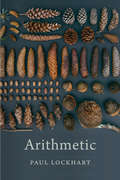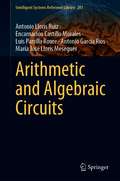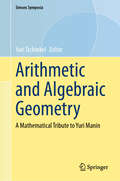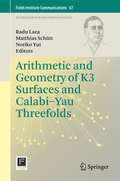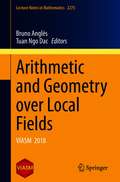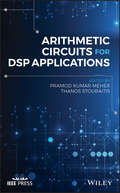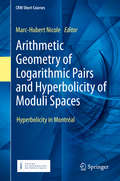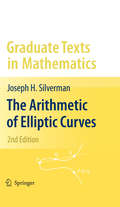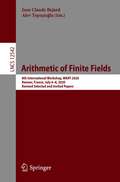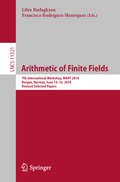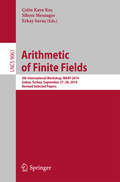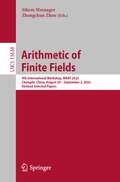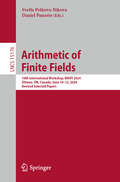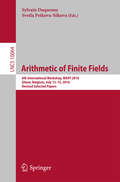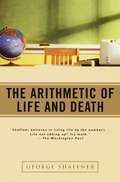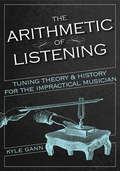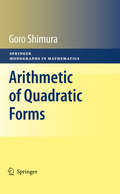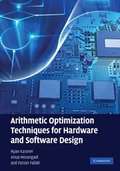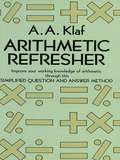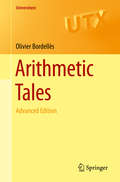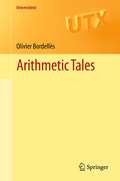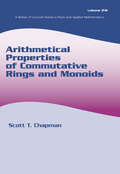- Table View
- List View
Arithmetic
by Paul LockhartPaul Lockhart reveals arithmetic not as the rote manipulation of numbers but as a set of ideas that exhibit the surprising behaviors usually reserved for higher branches of mathematics. In this entertaining survey, he explores the nature of counting and different number systems—Western and non-Western—and weighs the pluses and minuses of each.
Arithmetic 4 Work-text
by Judy HoweThis colorful workbook reviews facts and concepts learned in previous grades before moving on to new material. Concepts covered in Grade 4 include: multiplying and dividing by two-digit numbers, estimation, square measures, writing decimals as fractions, and simple geometry. A major emphasis is working with proper and improper fractions-adding, subtracting, multiplying, and finding the least common denominator.
Arithmetic and Algebraic Circuits (Intelligent Systems Reference Library #201)
by Antonio Lloris Ruiz Encarnación Castillo Morales Luis Parrilla Roure Antonio García Ríos María José Lloris MeseguerThis book presents a complete and accurate study of arithmetic and algebraic circuits. The first part offers a review of all important basic concepts: it describes simple circuits for the implementation of some basic arithmetic operations; it introduces theoretical basis for residue number systems; and describes some fundamental circuits for implementing the main modular operations that will be used in the text. Moreover, the book discusses floating-point representation of real numbers and the IEEE 754 standard. The second and core part of the book offers a deep study of arithmetic circuits and specific algorithms for their implementation. It covers the CORDIC algorithm, and optimized arithmetic circuits recently developed by the authors for adders and subtractors, as well as multipliers, dividers and special functions. It describes the implementation of basic algebraic circuits, such as LFSRs and cellular automata. Finally, it offers a complete study of Galois fields, showing some exemplary applications and discussing the advantages in comparison to other methods. This dense, self-contained text provides students, researchers and engineers, with extensive knowledge on and a deep understanding of arithmetic and algebraic circuits and their implementation.
Arithmetic and Algebraic Geometry: A Mathematical Tribute to Yuri Manin (Simons Symposia)
by Yuri TschinkelThis book is a tribute to the memory of Yuri Ivanovich Manin, who passed away on January 7, 2023. Manin was one of the giants of modern mathematics. His work covered a wide range of fields, including logic, number theory, geometry, mathematical physics, theoretical computer science, and linguistics. The contributions collected here are on topics close to his life-long passion: arithmetic and algebraic geometry.
Arithmetic and Geometry
by Luis Dieulefait Gerd Faltings D. R. Heath-Brown Yu. V. Manin B. Z. Moroz Jean-Pierre WintenbergerThe 'Arithmetic and Geometry' trimester, held at the Hausdorff Research Institute for Mathematics in Bonn, focussed on recent work on Serre's conjecture and on rational points on algebraic varieties. The resulting proceedings volume provides a modern overview of the subject for graduate students in arithmetic geometry and Diophantine geometry. It is also essential reading for any researcher wishing to keep abreast of the latest developments in the field. Highlights include Tim Browning's survey on applications of the circle method to rational points on algebraic varieties and Per Salberger's chapter on rational points on cubic hypersurfaces.
Arithmetic and Geometry of K3 Surfaces and Calabi–Yau Threefolds (Fields Institute Communications #67)
by Matthias Schütt Radu Laza Noriko YuiIn recent years, research in K3 surfaces and Calabi-Yau varieties has seen spectacular progress from both arithmetic and geometric points of view, which in turn continues to have a huge influence and impact in theoretical physics--in particular, in string theory. The workshop on Arithmetic and Geometry of K3 surfaces and Calabi-Yau threefolds, held at the Fields Institute (August 16-25, 2011), aimed to give a state-of-the-art survey of these new developments. This proceedings volume includes a representative sampling of the broad range of topics covered by the workshop. While the subjects range from arithmetic geometry through algebraic geometry and differential geometry to mathematical physics, the papers are naturally related by the common theme of Calabi-Yau varieties. With the big variety of branches of mathematics and mathematical physics touched upon, this area reveals many deep connections between subjects previously considered unrelated. Unlike most other conferences, the 2011 Calabi-Yau workshop started with 3 days of introductory lectures. A selection of 4 of these lectures is included in this volume. These lectures can be used as a starting point for the graduate students and other junior researchers, or as a guide to the subject.
Arithmetic and Geometry over Local Fields: VIASM 2018 (Lecture Notes in Mathematics #2275)
by Bruno Anglès Tuan Ngo DacThis volume introduces some recent developments in Arithmetic Geometry over local fields. Its seven chapters are centered around two common themes: the study of Drinfeld modules and non-Archimedean analytic geometry. The notes grew out of lectures held during the research program "Arithmetic and geometry of local and global fields" which took place at the Vietnam Institute of Advanced Study in Mathematics (VIASM) from June to August 2018. The authors, leading experts in the field, have put great effort into making the text as self-contained as possible, introducing the basic tools of the subject. The numerous concrete examples and suggested research problems will enable graduate students and young researchers to quickly reach the frontiers of this fascinating branch of mathematics.
Arithmetic Circuits for DSP Applications
by Thanos Stouraitis Pramod Kumar MeherA comprehensive guide to the fundamental concepts, designs, and implementation schemes, performance considerations, and applications of arithmetic circuits for DSP Arithmetic Circuits for DSP Applications is a complete resource on arithmetic circuits for digital signal processing (DSP). It covers the key concepts, designs and developments of different types of arithmetic circuits, which can be used for improving the efficiency of implementation of a multitude of DSP applications. Each chapter includes various applications of the respective class of arithmetic circuits along with information on the future scope of research. Written for students, engineers, and researchers in electrical and computer engineering, this comprehensive text offers a clear understanding of different types of arithmetic circuits used for digital signal processing applications. The text includes contributions from noted researchers on a wide range of topics, including a review of circuits used in implementing basic operations like additions and multiplications; distributed arithmetic as a technique for the multiplier-less implementation of inner products for DSP applications; discussions on look up table-based techniques and their key applications; CORDIC circuits for calculation of trigonometric, hyperbolic and logarithmic functions; real and complex multiplications, division, and square-root; solution of linear systems; eigenvalue estimation; singular value decomposition; QR factorization and many other functions through the use of simple shift-add operations; and much more. This book serves as a comprehensive resource, which describes the arithmetic circuits as fundamental building blocks for state-of-the-art DSP and reviews in - depth the scope of their applications.
Arithmetic Geometry of Logarithmic Pairs and Hyperbolicity of Moduli Spaces: Hyperbolicity in Montréal (CRM Short Courses)
by Marc-Hubert NicoleThis textbook introduces exciting new developments and cutting-edge results on the theme of hyperbolicity. Written by leading experts in their respective fields, the chapters stem from mini-courses given alongside three workshops that took place in Montréal between 2018 and 2019. Each chapter is self-contained, including an overview of preliminaries for each respective topic. This approach captures the spirit of the original lectures, which prepared graduate students and those new to the field for the technical talks in the program. The four chapters turn the spotlight on the following pivotal themes:The basic notions of o-minimal geometry, which build to the proof of the Ax–Schanuel conjecture for variations of Hodge structures;A broad introduction to the theory of orbifold pairs and Campana's conjectures, with a special emphasis on the arithmetic perspective;A systematic presentation and comparison between different notions of hyperbolicity, as an introduction to the Lang–Vojta conjectures in the projective case;An exploration of hyperbolicity and the Lang–Vojta conjectures in the general case of quasi-projective varieties.Arithmetic Geometry of Logarithmic Pairs and Hyperbolicity of Moduli Spaces is an ideal resource for graduate students and researchers in number theory, complex algebraic geometry, and arithmetic geometry. A basic course in algebraic geometry is assumed, along with some familiarity with the vocabulary of algebraic number theory.
The Arithmetic of Elliptic Curves
by Joseph H. SilvermanThe theory of elliptic curves is distinguished by its long history and by the diversity of the methods that have been used in its study. This book treats the arithmetic approach in its modern formulation, through the use of basic algebraic number theory and algebraic geometry. Following a brief discussion of the necessary algebro-geometric results, the book proceeds with an exposition of the geometry and the formal group of elliptic curves, elliptic curves over finite fields, the complex numbers, local fields, and global fields. Final chapters deal with integral and rational points, including Siegels theorem and explicit computations for the curve Y = X + DX, while three appendices conclude the whole: Elliptic Curves in Characteristics 2 and 3, Group Cohomology, and an overview of more advanced topics.
Arithmetic of Finite Fields: 8th International Workshop, WAIFI 2020, Rennes, France, July 6–8, 2020, Revised Selected and Invited Papers (Lecture Notes in Computer Science #12542)
by Jean Claude Bajard Alev TopuzoğluThis book constitutes the thoroughly refereed post-workshop proceedings of the 8th International Workshop on the Arithmetic of Finite Field, WAIFI 2020, held in Rennes, France in July 2020. Due to the COVID-19, the workshop was held online. The 12 revised full papers and 3 invited talks presented were carefully reviewed and selected from 22 submissions. The papers are organized in topical sections on invited talks, Finite Field Arithmetic, Coding Theory, Network Security and much more.
Arithmetic of Finite Fields: 7th International Workshop, WAIFI 2018, Bergen, Norway, June 14-16, 2018, Revised Selected Papers (Lecture Notes in Computer Science #11321)
by Lilya Budaghyan Francisco Rodríguez-HenríquezThis book constitutes the thoroughly refereed post-workshop proceedings of the 7th International Workshop on the Arithmetic of Finite Field, WAIFI 2018, held in Bergen, Norway, in June 2018. The 14 revised full papers and six invited talks presented were carefully reviewed and selected from 26 submissions. The papers are organized in topical sections on invited talks; elliptic curves; hardware implementations; arithmetic and applications of finite fields and cryptography.
Arithmetic of Finite Fields: 5th International Workshop, WAIFI 2014, Gebze, Turkey, September 27-28, 2014. Revised Selected Papers (Lecture Notes in Computer Science #9061)
by Çetin Kaya Koç Sihem Mesnager Erkay SavaşThis book constitutes the refereed proceedings of the 5th International Workshop on the Arithmetic of Finite Field, WAIFI 2014, held in Gebze, Turkey, in September 2014. The 9 revised full papers and 43 invited talks presented were carefully reviewed and selected from 27 submissions. This workshop is a forum of mathematicians, computer scientists, engineers and physicists performing research on finite field arithmetic, interested in communicating the advances in the theory, applications, and implementations of finite fields. The workshop will help to bridge the gap between the mathematical theory of finite fields and their hardware/software implementations and technical applications.
Arithmetic of Finite Fields: 9th International Workshop, WAIFI 2022, Chengdu, China, August 29 – September 2, 2022, Revised Selected Papers (Lecture Notes in Computer Science #13638)
by Sihem Mesnager Zhengchun ZhouThis book constitutes the thoroughly refereed post-workshop proceedings of the 8th International Workshop on the Arithmetic of Finite Field, WAIFI 2022, held in Chengdu, China, in August – September 2022.The 19 revised full papers and 3 invited talks presented were carefully reviewed and selected from 25 submissions. The papers are organized in topical sections: structures in finite fields; efficient finite field arithmetic; coding theory; cryptography; sequences.
Arithmetic of Finite Fields: 10th International Workshop, WAIFI 2024, Ottawa, ON, Canada, June 10–12, 2024, Revised Selected Papers (Lecture Notes in Computer Science #15176)
by Svetla Petkova-Nikova Daniel PanarioThis book constitutes the refereed proceedings of the 10th International Workshop on Arithmetic of Finite Fields, WAIFI 2024, held in Ottawa, Ontario, Canada, during June 10–12, 2024. The 17 full papers included in this book were carefully reviewed and selected from 29 submissions. They were organized in topical sections as follows: Invited talks; Coding theory; Cryptography and Boolean functions; and Postquantum Cryptography.
Arithmetic of Finite Fields: 6th International Workshop, WAIFI 2016, Ghent, Belgium, July 13-15, 2016, Revised Selected Papers (Lecture Notes in Computer Science #10064)
by Sylvain Duquesne and Svetla Petkova-NikovaThis book constitutes the thoroughly refereed post-workshop proceedings of the 6th International Workshop on the Arithmetic of Finite Field, WAIFI 2016, held in Ghent, Belgium, in July 2016. The 14 revised full papers and 3 invited talks presented were carefully reviewed and selected from 38 submissions. The papers are organized in topical sections on invited talks; elliptic curves; applications; irreducible polynomials; applications to cryptography; Boolean functions; cryptography; cryptography and Boolean functions.
The Arithmetic of Life and Death
by George ShaffnerWhether you realize it or not, numbers are everywhere--and integral to almost every facet of your life . . . from your next raise in pay to the inevitable rise of inflation, your weekly family budget to your end of the national debt. And as George Shaffner amazingly reveals, there are discerning answers (and a great measure of comfort) in numbers. In The Arithmetic of Life, he applies the basic principles of mathematics--addition, subtraction, multiplication, and division--to some of the most profound and just plain puzzling questions of our time.Illuminated with anecdotes, humor, and insight, each chapter explains a unique part of life that can be understood only through the magic of numbers. Whether it's an unconventional theory on why more things go wrong than right, a simple calculation of how much it will cost you to smoke for a lifetime, why crime (accumulatively) doesn't pay, or a glimpse into the probability of life after death, this enlightening and lucidly reasoned book will forever change the way you think about numbers--and the world around you.From the Trade Paperback edition.
The Arithmetic of Listening: Tuning Theory and History for the Impractical Musician
by Kyle GannTuning is the secret lens through which the history of music falls into focus, says Kyle Gann. Yet in Western circles, no other musical issue is so ignored, so taken for granted, so shoved into the corners of musical discourse.A classroom essential and an invaluable reference, The Arithmetic of Listening offers beginners the grounding in music theory necessary to find their own way into microtonality and the places it may take them. Moving from ancient Greece to the present, Kyle Gann delves into the infinite tunings available to any musician who feels straitjacketed by obedience to standardized Western European tuning. He introduces the concept of the harmonic series and demonstrates its relationship to equal-tempered and well-tempered tuning. He also explores recent experimental tuning models that exploit smaller intervals between pitches to create new sounds and harmonies.Systematic and accessible, The Arithmetic of Music provides a much-needed primer for the wide range of tuning systems that have informed Western music.
Arithmetic of Quadratic Forms (Springer Monographs in Mathematics #109)
by Goro ShimuraThis book is divided into two parts. The first part is preliminary and consists of algebraic number theory and the theory of semisimple algebras. There are two principal topics: classification of quadratic forms and quadratic Diophantine equations. The second topic is a new framework which contains the investigation of Gauss on the sums of three squares as a special case. To make the book concise, the author proves some basic theorems in number theory only in some special cases. However, the book is self-contained when the base field is the rational number field, and the main theorems are stated with an arbitrary number field as the base field. So the reader familiar with class field theory will be able to learn the arithmetic theory of quadratic forms with no further references.
Arithmetic Optimization Techniques for Hardware and Software Design
by Ryan Kastner Anup Hosangadi Farzan FallahObtain better system performance, lower energy consumption, and avoid hand-coding arithmetic functions with this concise guide to automated optimization techniques for hardware and software design. High-level compiler optimizations and high-speed architectures for implementing FIR filters are covered, which can improve performance in communications, signal processing, computer graphics, and cryptography. Clearly explained algorithms and illustrative examples throughout make it easy to understand the techniques and write software for their implementation. Background information on the synthesis of arithmetic expressions and computer arithmetic is also included, making the book ideal for new-comers to the subject. This is an invaluable resource for researchers, professionals, and graduate students working in system level design and automation, compilers, and VLSI CAD.
Arithmetic Refresher (Dover Books on Mathematics)
by A. A. KlafThe farther we get from our grade school days, the easier it is to forget those operations and nuances of arithmetical computation that keep recurring in our daily lives: interest and discount problems, time-payment calculations, tax problems, and so on.This handy book is designed to streamline your methods and resharpen your calculation skills for a variety of situations. Starting with the most elementary operations, the book goes on to cover all basic topics and processes of arithmetic: addition, subtraction, multiplication, division, fractions, percentage, interest, ratio and proportion, denominate numbers, averages, etc. The text continues into other useful matters, such as powers and roots, logarithms, positive and negative numbers, harmonic progression, and introductory concepts of algebra.Entirely practical in approach and using an easy-to-follow question and answer style, this book covers a wide range of common knotty areas: filling and emptying receptacles, scales for models and maps, business and financial calculations (partial payment problems, compound interest, bank and sales discount, profit and loss problems, etc.), angle measurement, mixtures and solutions, graph and chart problems, and the like.The discussion contains numerous alternate and short-cut methods, such as quick ways to figure compound interest; to square a number from 1 to 100; to divide by 5, 25, 125, 99, etc.; to multiply two 2-digit numbers having the same figure in the tens place; and many more. These valuable tips, together with the huge fund of exercise problems (a total of 809, half of them answered in an appendix), help you to increase your computational proficiency and speed, and make this an extremely useful volume to have on your shelf at home or at work. Anyone who has to do any figuring at all -- housewife, merchant, student -- will profit from this refresher. Parents will find it an excellent source of material for helping children in school work.
Arithmetic Tales: Advanced Edition (Universitext)
by Olivier BordellèsThis textbook covers a wide array of topics in analytic and multiplicative number theory, suitable for graduate level courses.Extensively revised and extended, this Advanced Edition takes a deeper dive into the subject, with the elementary topics of the previous edition making way for a fuller treatment of more advanced topics. The core themes of the distribution of prime numbers, arithmetic functions, lattice points, exponential sums and number fields now contain many more details and additional topics. In addition to covering a range of classical and standard results, some recent work on a variety of topics is discussed in the book, including arithmetic functions of several variables, bounded gaps between prime numbers à la Yitang Zhang, Mordell's method for exponential sums over finite fields, the resonance method for the Riemann zeta function, the Hooley divisor function, and many others. Throughout the book, the emphasis is on explicit results.Assuming only familiarity with elementary number theory and analysis at an undergraduate level, this textbook provides an accessible gateway to a rich and active area of number theory. With an abundance of new topics and 50% more exercises, all with solutions, it is now an even better guide for independent study.
Arithmetic Tales (Universitext)
by Olivier Bordellès Véronique BordellèsNumber theory was once famously labeled the queen of mathematics by Gauss. The multiplicative structure of the integers in particular deals with many fascinating problems some of which are easy to understand but very difficult to solve. In the past, a variety of very different techniques has been applied to further its understanding. Classical methods in analytic theory such as Mertens' theorem and Chebyshev's inequalities and the celebrated Prime Number Theorem give estimates for the distribution of prime numbers. Later on, multiplicative structure of integers leads to multiplicative arithmetical functions for which there are many important examples in number theory. Their theory involves the Dirichlet convolution product which arises with the inclusion of several summation techniques and a survey of classical results such as Hall and Tenenbaum's theorem and the Möbius Inversion Formula. Another topic is the counting integer points close to smooth curves and its relation to the distribution of squarefree numbers, which is rarely covered in existing texts. Final chapters focus on exponential sums and algebraic number fields. A number of exercises at varying levels are also included. Topics in Multiplicative Number Theory introduces offers a comprehensive introduction into these topics with an emphasis on analytic number theory. Since it requires very little technical expertise it will appeal to a wide target group including upper level undergraduates, doctoral and masters level students.
Arithmetic Work-text 5
by Judy HoweArithmetic 5 contains a variety of exercises involving new/review material in each lesson. The workbook includes 169 lessons (excluding tests). Supplementary Exercises and Homework Exercises. The handbook at the end of the book contains facts, rules, and measures which are given throughout the workbook. Although all new material is presented at top of a workbook page, the workbook is not designed to be used without a teacher. Arithmetic 5 Curriculum/Lesson Plans, available separately or as part of the Grade 5 Curriculum, and the Teacher Edition provide complete daily plans for teaching, reviewing, and testing. The Teacher Edition also includes solutions to all exercises in the text. Student Quizzes, Tests, and Speed Drills are correlated with the work-text.
Arithmetical Properties of Commutative Rings and Monoids (Lecture Notes in Pure and Applied Mathematics)
by Scott T. ChapmanThe study of nonunique factorizations of elements into irreducible elements in commutative rings and monoids has emerged as an independent area of research only over the last 30 years and has enjoyed a recent flurry of activity and advancement. This book presents the proceedings of two recent meetings that gathered key researchers from around the w
